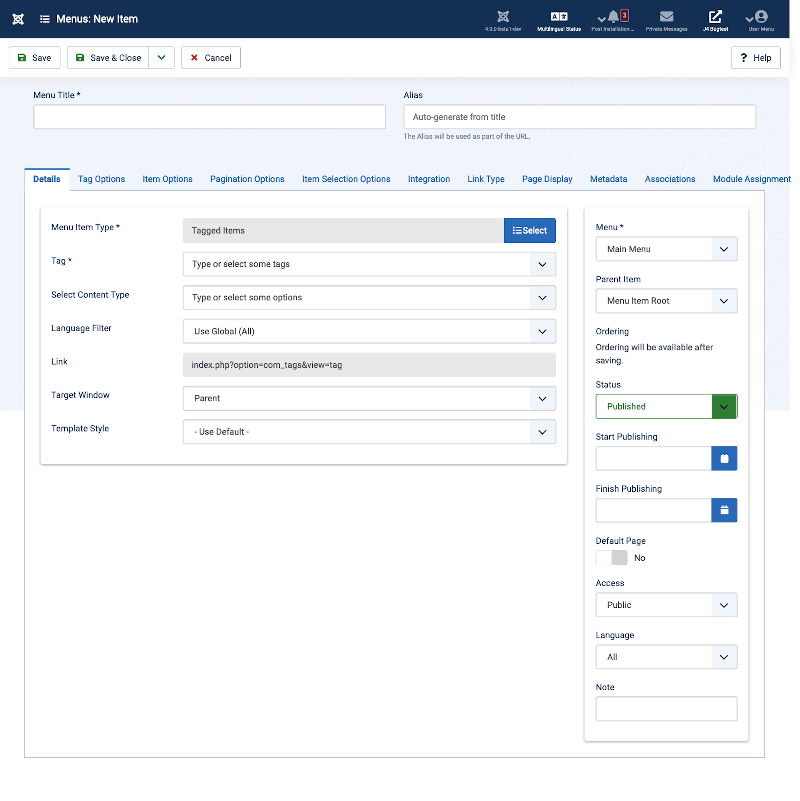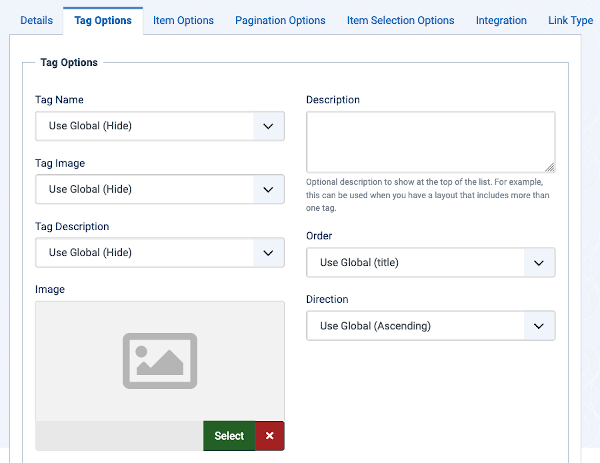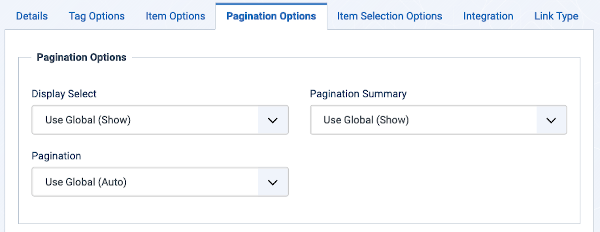Joomla Help Screens
Manual Index
Menu Item: Tagged Items
Description¶
The Tagged Items menu item type is used to create a page to display content with selected tags.
How To Access¶
To create a new Tagged Items menu item:
- Select Menus → [name of the menu] from the Administrator
menu (for example, Menus → Main Menu). Then...
- Select the New button in the Toolbar. Then...
- Select the Menu Item Type Select button.

- In the modal dialog select the Tags item to open a list and then select the Tagged Items item.
To edit an existing Tagged Items menu item:
- Select its Title in the Menus: Items list.
Screenshot¶

Form Fields¶
- Menu Title: The title that will display for this menu item.
- Alias. The internal name of the item. Normally, you can leave this blank and Joomla will fill in a default value Title in lower case and with dashes instead of spaces. Learn more.
Details Tab¶
Left Panel
- Menu Item Type. The Menu Item Type selected when this menu item was created. This can be one of the core menu item types or a menu item type provided by an installed extension.
- Tag. Select the tag to use.
- Content Type. Only tags of the selected types will be displayed (optional).
- Language Filter. (Use Global (All)/All/Current/English (en-GB)/...). Optionally filter the list of tags based on language.
- Link. The system-generated link for this menu item. This field cannot be changed and is for information only.
- Target Window. Select from the drop-down list.
- Template Style. Select from the drop-down list.
Right Panel
- Menu. Shows which menu the link will appear in.
- Parent Item. The parent menu item for this menu item. Used to determine whether a Menu Item is a top-level item or a submenu item. Select 'Menu Item Root' (the default value) if this is a top-level Menu Item. Otherwise, select the Menu Item that is this item's parent.
-
Ordering. You can change the order of an item within a list as
follows:
- If the list Filter Options include a Position filter select the desired Position. This will limit the list to items that are assigned to that Position.
- Select the Ordering icon
 in the Table
heading to make it the active ordering item. The ordering icons in
each row will change from light grey to dark grey and the pointer
will change to a drag arrow on hover.
in the Table
heading to make it the active ordering item. The ordering icons in
each row will change from light grey to dark grey and the pointer
will change to a drag arrow on hover. - Select one of the Ordering icons
 and
drag it up or down to change the position of that row in the list.
The items will display in the new order within the Position.
and
drag it up or down to change the position of that row in the list.
The items will display in the new order within the Position.
- Status. The published status of the item.
- Start Publishing. Date and time to start publishing. Use this field if you want to enter content ahead of time and then have it published automatically at a future time.
- Finish Publishing. Date and time to finish publishing. Use this field if you want to have content automatically changed to Unpublished state at a future time (for example, when it is no longer applicable).
-
Default Page. If Yes, this menu item is the default or home page
for the site. There must be exactly one menu item set as the default
page. You can change the default page in two ways:
- Click on the Home column of the desired menu item in the Menus: Items screen.
- Open the menu item for the new default page and change the Default Page setting to Yes.
- Access. The viewing Access Level for this item.
- Language. Item language.
- Note. This is normally for the site administrator's use (for example, to document information about this item) and does not show in the Frontend of the site.
Tag Options Tab¶

- Show Tag Name. (Use Global(Hide)/Hide/Show). For a layout with one tag, show the tag name.
- Tag Image. (Use Global(Hide)/Hide/Show). For a layout with one tag, show the image for the tag.
- Tag Description. (Use Global(Hide)/Hide/Show). Show or hide the description for the tag (only used when a single tag is selected).
- Image. Select or upload the image.
- Description. The description for the item. Category, Subcategory and Web Link descriptions may be shown on web pages, depending on the parameter settings. These descriptions are entered using the same editor that is used for Articles.
- Ordering: (default). The column in which to sort displayed items in the table. The values are the same as the column heading names.
- Direction. Sort order. Descending is highest to lowest. Ascending is lowest to highest.
Item Options Tab¶

- Item Image: Show the image for each item.
- Item Description: Show or hide the description for each item in the list. The lenght may be limited using the Maximum Character option.
- Maximum Characters: The maximum number of characters to display from the description in each tag.
- Filter Field: Show or hide field for the list.
Pagination Options Tab¶

- Display Select. (Use Global/Hide/Show) Whether to hide or show the Display # control that allows the user to select the number of items to show in the list. An example of how it is shown in the Front End (website) view below.

If there are more items than this number, you can use the page navigation buttons (Start, Prev, Next, End, and page numbers) to navigate between pages. Note that if you have a large number of items, it may be helpful to use the Filter options, located above the column headings, to limit which items display.
- Pagination. Hide or Show Pagination support. Pagination provides page links at the bottom of the page that allow the User to navigate to additional pages. These are needed if the listed items will not fit on one page. An example is shown below.
![]()
The following options are available.
- Use Global: Use the default value from the component options screen.
- Auto: Pagination links shown if needed.
- Show: Pagination links shown if needed.
- Hide: Pagination links not shown. Note: In this case, Users will not be able to navigate to additional pages.
- Pagination Results. Hide or Show the current page number and total pages (e.g., "Page 1 of 2") at the bottom of each page. Use Global will use the default value from the component options.
Item Selection Options Tab¶

- Match Type: All will return items that have all of the tags. Any will return items that have at least one of the tags.
- Child Tags: Include or exclude child tags from the result list for a tag.
Integration Tab¶

- Show Feed Link. (Use Global/Hide/Show) Whether to Hide or Show a link to a news feed (RSS Feed). If set to Show, a Feed Link will show up as a feed icon in the address bar of most modern browsers.
Common Options¶
See Menus: Edit/New Item for help on fields common to all Menu Item types located in the following Tabs:
- Link Type
- Page Display
- Metadata
- Associations
- Module Assignment
Toolbar¶
At the top of the page you will see the toolbar shown in the Screenshot above. The functions are:
- Save. Saves the menu item and stays in the current screen.
- Save & Close. Saves the menu item and closes the current screen.
- Save & New. Saves the menu item and keeps the editing screen open and ready to create another menu item.
- Cancel. Closes the current screen and returns to the previous screen without saving any modifications you may have made. Or
- Close. Closes the current screen and returns to the previous screen without saving any modifications you may have made.
- Help. Opens this help screen.
Front End Screenshot¶
Example Front End Site images are generic images using Joomla! core
installation supplied free Front End Templates. The actual view can
depend on the installed custom template used and the template's style
for those views on a Joomla! website. Tags List Layout: 
Related Information¶
- Menus Menu Item Tags Items Compact List Used to create a 'Compact List of Tagged Items' page per tag(s) selected.
- Menus Menu Item Tags Items List All Used to create a 'List of All Tags' page per tag(s) selected.